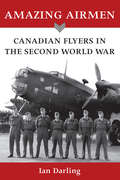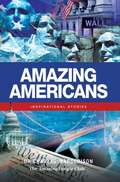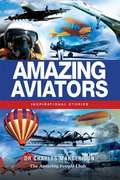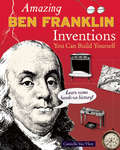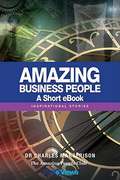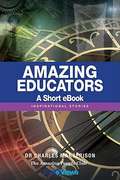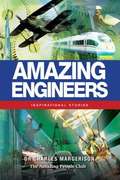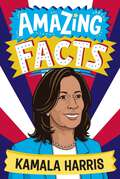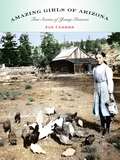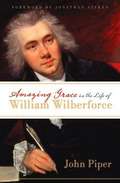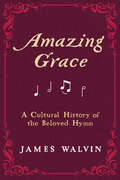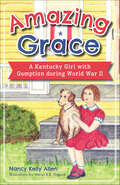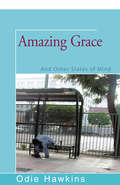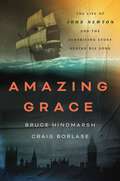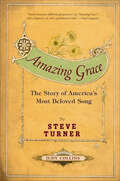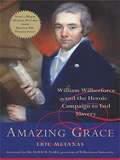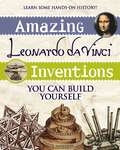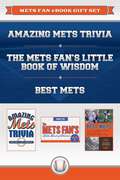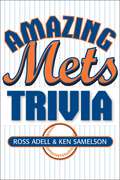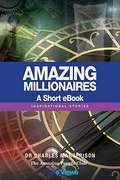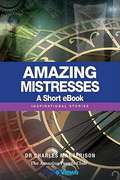- Table View
- List View
Amazing Airmen: Canadian Flyers in the Second World War
by Ian DarlingCanadian and British airmen engaged in fierce and deadly battles in the skies over Europe during the Second World War. Those who survived often had to overcome incredible obstacles to do so — dodging bullets and German troops, escaping from burning planes and enduring forced marches if they became prisoners. In one story, a tail gunner from Montreal survived despite being unconscious when blown out of his bomber. Another story describes how the crew of a navigator from Ottawa used chewing gum to fill holes in their aircraft. And another tells how a pilot from northern Ontario parachuted out of his plane and became the target of a German machine-gunner, but within hours 120 Germans surrendered to him. These painstakingly researched stories will enable you to feel what now-aging veterans endured when they were young men in the air war against Nazi Germany.
Amazing Americans: Inspirational Stories
by Charles MargerisonWould you like to have met Abraham Lincoln and had a discussion about his life and career? Can you imagine what George Washington would have said if he was interviewed about his achievements? Would you like to explore how Amelia Earhart, the famous aviation pioneer, broke may speed and travel records and so inspired people around the world. Experience these and other outstanding stories in Amazing Americans and be inspired by some of the amazing people who helped shape the United States.
Amazing Artists - A Short eBook
by Charles MargerisonIn this unique collection of audio stories about some of the world's most amazing artists, meet Michelangelo in 1485, when he was born in a small village in Tuscany. You'll travel with him to Rome at the age of 21 and understand how he came to complete some of the world's most influential pieces of art, including the Statue of David and the awe-inspiring ceiling of the Sistine Chapel, which took him four years to complete. Meet also another Italian - the fascinating Rosalba Carriera, who from lowly beginnings went on to become an influential Rococo painter. Samuel Morse is of course known for developing Morse code however, few people realize that he was actually an artist. He painted influential figures including President John Adams and was the artist of pieces including Dying Hercules. Finally you'll get a unique insight to the amazing life of Leonardo da Vinci, who many believe to be the most diversely talented man to have lived. Understand his major works, including The Last Supper and Virgin of the Rocks within the context of his real life. Each story comes to life through BioViews®. These are short biographical narratives, similar to interviews. They provide an easy way of learning about amazing people who made major contributions and changed our world.
Amazing Aviators
by Charles MargerisonAs the world becomes smaller and air travel more commonplace, do we always remember those amazing people whose bravery and vision has made it possible for us to travel around to the far ends of the earth? In this unique collection of inspirational stories from The Amazing People Club®, take a fascinating flight through the lives of some of the world's most celebrated aviators!From the great dreams of Joseph Montgolfier, inventor of the hot-air balloon, to the incredible innovations of the Wright Brothers, whose work on bicycles inspired them to invent a system of controlling aircraft; the principle of which is still used today. From the bravery and pioneering spirit of Amelia Earhart to the tenacious spirit of Yuri Gagarin, there is much to be learnt from the lives of these amazing people who all played key roles in the history of aviation. Experience the excitement of great aviation breakthroughs in this unique collection of amazing stories. Travel with Frank Whittle, who developed the jet engine. Learn how Igor Sikorsky created the helicopter. Find our how aviation engineers and brave pilots created the airline industry. These stories all come alive through BioViews®.A BioView® is a short biographical story, similar to an interview, about an amazing person. These stories offer an inspirational way of learning about people who made major contributions to our world. The unique format and flow enables each person's story to come alive, as if it is being personally told to you, and reflects their interests, emotions and passions.
Amazing BEN FRANKLIN Inventions
by Carmella Van VleetAmazing Ben Franklin Inventions You Can Build Yourself introduces readers ages 9 and up to the life and times of one of America's greatest thinkers with over 25 hands-on building projects and activities. From his groundbreaking scientific discoveries and inventions to his career as a writer, printer, and politician, Amazing Ben Franklin Inventions gives young readers a comprehensive look at the man who gave us the lightning rod, the armonica, bifocals, the post office, the first public library, Poor Richard's Almanac, and so much more. Amazing Ben Franklin Inventions provides detailed step-by-step instructions, diagrams, and templates for creating each project. Historical facts and anecdotes, biographies, and fascinating trivia support the fun projects and teach readers about the courage, creativity, and determination of Ben Franklin and a young America coming into its own.
Amazing Business People - A Short eBook
by Charles MargerisonBusiness makes the world go round. This unique audio collection from The Amazing People Club explores the lives of four amazing people who all enjoyed global success in a variety of ways. Get an insight into the life of Henry Ford, the man behind one of the biggest car brands in the world. Born on a farm, Henry's journey took him to Detroit, where he built the first mass produced vehicles - the Model T, the Model A and the system of 'Fordism'. His talent for invention and machines was inspired by other amazing individuals, including Thomas Edison. Also meet Beulah Henry, called 'Lady Edison' by many; she was a prolific inventor. Many people have actually never heard of her despite her development of over 101 inventions! Be amazed by Henry Bessemer who played a critical role in steel making and steam engines which drove the industrial revolution and find out about George de Mestral whose ingenuity was responsible for Velcro, now used all over the world. It's a great example of the fact that behind every invention, there is an amazing story! Each story comes to life through BioViews®. These are short biographical narratives, similar to interviews. They provide an easy way of learning about amazing people who made major contributions and changed our world.
Amazing Educators - A Short eBook
by Charles MargerisonProgress and education go hand in hand. This unique collection from The Amazing People Club explores the lives of four influential educators who recognized the importance of sharing knowledge to improve people's life and acted on it. Meet Maria Montessori whose revolutionary educational method has inspired public and private schools throughout the world. While many have heard of Montessori schools, most don't know about her pivotal work in India or the fact she was the first woman to qualify as a doctor in Italy. Explore the life of another amazing woman who dedicated her life to educating people. Inspired by her own teacher, Helen Keller became the first deaf and blind person to earn her degree. She traveled the world to educate people on politics and women's rights. You'll also meet Aristotle, who was taught by Plato and in turn taught Alexander the Great. Without doubt, he is one of the most important figures in Western philosophy. Finally you'll come "face to face" with the lesser-known, but no less amazing, Dr. Reg Revans. His is one of the great management thinkers and pioneered Action Learning, a process we can all use in our lives. Each story comes to life through BioViews®. These are short biographical narratives, similar to interviews. They provide an easy way of learning about amazing people who made major contributions and changed our world.
Amazing Engineers
by Charles MargerisonWhen problems crop up, we need solutions. When something needs to be improved, or made more efficient, we need innovative ideas and positive action. Take inspiration from some of the world's most celebrated engineers whose inspirational life stories are celebrated in this new collection from The Amazing People Club®.Find out how Charles Babbage invented the first computer and discover life story of the man behind the invention. Make the connection between Peter Henlein's pocket watch invention and the wristwatches of today. Marvel at the incredible accomplishments of Isambard Kingdom Brunel, whose innovations helped solve many longstanding engineering problems. Discover the genius of Alexander Graham Bell, whose invention of the telephone changed our world forever. Each story comes alive through BioViews®.A BioView® is a short biographical story, similar to an interview, about an amazing person. These stories offer an inspirational way of learning about people who made major contributions to our world. The unique format and flow enables each person's story to come alive, as if it is being personally told to you, and reflects their interests, emotions and passions.
Amazing Explorers - Volume 2 - A Short eBook
by Charles MargerisonThe geography of our amazing world has come about through the contributions of many. The Amazing People Club invites you into the adventurous and inspirational lives of five amazing explorers, whose voyages around the earth have contributed to civilization as we know it today. Take to the skies with Amy Johnson as she explored new boundaries in aviation, setting world records along the way. Trek the wilderness lands west of the Mississippi with Meriwether Lewis on the historical Lewis and Clark Expedition which lasted 28 months. Join David Livingstone, Marco Polo and Jacques Cartier as they explored new worlds and paved the way for modern settlements. Their tenacious spirits combined with their sense of exploratory adventure have had a major impact on our modern world Each story comes to life through BioViews®. These are short biographical narratives, similar to interviews. They provide an easy way of learning about amazing people who made major contributions and changed our world.
Amazing Facts: Kamala Harris
by Clive GiffordCelebrate the 2024 election with this fascinating book of facts about Kamala Harris, her family, her childhood, her hobbies, and her homelife—perfect for 8+ and fully illustrated throughout!Did you know?Her father was born in Jamaica and her mother was born in India.She has a younger sister named Maya.She became vice president of the United States on January 20, 2021.Find over one hundred extraordinary facts in this fun-packed book, the perfect gift for kids who love American history makers!
Amazing Girls of Arizona: True Stories Of Young Pioneers
by Jan CleereFrom the Diary ofAnne Frank to Anne of Green Gables, young women love to read stories about real girls who faced incredible challenges and shared indelible truths about the human spirit. Jan Cleere has compiled a wonderful collection of such stories, for a wide range of readers from ten-year-old girls to older readers fascinated by women&’s history. Meet Laurette Lovell, born in 1869 with a severe leg deformity, who at age thirteen started on her path to be a renowned pottery artist and painter. Edith Bass, born in 1896, began wrangling mules before the age of nine, leading pack strings up and down the dangerous paths into the Grand Canyon. These two young women, and nine others, are profiled magnificently alongside historic photographs. Today&’s readers love to read bold adventures. They&’ll never forget these stories of real girls who conquered the West in their own style, spending most or all of their childhood in Arizona.Jan Cleere is a historical researcher and the author of More Than Petticoats: Remarkable Nevada Women, among other books. She lives in Oro Valley, Arizona.
Amazing Grace in the Life of William Wilberforce
by John Piper Jonathan Aitken"John Piper's succinct and superbly perceptive study of William Wilberforce deserves to become an acclaimed bestseller. It not only tells the story of a great man's life--it also tells us how to understand the ultimate source of his greatness and happiness. Moreover, that understanding goes far deeper than the abolitionist achievements for which Wilberforce is honored, astounding though they were. William Wilberforce's secret, as revealed in this book, was that he made the journey from self-centeredness, achievement-centeredness, and political-centeredness to God-centeredness. And he made it with Christlike joy." -Jonathan Aitken. Against great obstacles William Wilberforce, an evangelical Christian and a member of Parliament, fought for the abolition of the African slave trade and against slavery itself until they were both illegal in the British Empire. Many are aware of Wilberforce's role in bringing an end to slavery in Great Britain, but few have taken the time to examine the beliefs and motivations that spurred him on for decades. In this concise volume, John Piper tells the story of how Wilberforce was transformed from an unbelieving, young politician into a radically God-centered Christian, and how his deep spirituality helped to change the moral outlook of a nation. As world leaders debate over how to deal with a host of social justice and humanitarian crises, a closer look at Wilberforce's life and faith serves as an encouragement and example to all believers.
Amazing Grace: A Cultural History of the Beloved Hymn
by James WalvinA fascinating journey through the history of "Amazing Grace," one of the transatlantic world's most popular hymns and a powerful anthem for humanity. Sung in moments of personal isolation or on state occasions watched by millions, "Amazing Grace" has become an unparalleled anthem for humankind. How did a simple Christian hymn, written in a remote English vicarage in 1772, come to hold such sway over millions in all corners of the modern world? With this short, engaging cultural history, James Walvin offers an explanation. The greatest paradox is that the author of "Amazing Grace," John Newton, was a former Liverpool slave captain. Walvin follows the song across the Atlantic to track how it became part of the cause for abolition and galvanized decades of movements and trends in American history and popular culture. By the end of the twentieth century, "Amazing Grace" was performed in Soweto and Vanuatu, by political dissidents in China, and by Kikuyu women in Kenya. No other song has acquired such global resonance as "Amazing Grace," and its fascinating history is well worth knowing.
Amazing Grace: A Kentucky Girl with Gumption during World War II
by Nancy AllenEleven-year-old Grace Ann Brewer lives a normal life until her father joins the army in 1944 during World War II. When her family moves from Hazard to Ashland, Grace faces challenges entirely new to her--life without her father, fitting in at a new school and living in a new house are only a few. But a closer relationship with her grandmother, her spunky dog Spot and the letters she writes to her father overseas give her the courage she needs and the amazing strength to fight her own battles on the homefront. Author Nancy Kelly Allen tells the triumphant story of Grace's coming of age.
Amazing Grace: And Other States of Mind
by Odie HawkinsAn enchanting intro to a collection of unforgettable characters--Elizabeth, "Queen of the Projects"; the girl "Billie" who sings like Lady Day; young Randolph who, to his family's embarrassment, grows a second head for a while; Dean Dale Jackson, talented writer, sculptor, auto mechanic, and dedicated to the underbelly of a bottle; the Vernon family upwardly mobile but required by a will to grow cotton in their suburban backyard; and Marlene and James, who find happiness in an unexpected way, in marriage.
Amazing Grace: The Life of John Newton and the Surprising Story Behind His Song
by Craig Borlase Bruce HindmarshAmazing Grace is the surprising true story of John Newton, author of the song that has touched millions. A biography that reads like a novel, it reveals Newton&’s dramatic story of sin and salvation as a slave trader before his ultimate transformation to speaking out against the horror of slavery. His story speaks to the brokenness within us all and our need for God&’s amazing grace—and reveals the truth behind his song.Amazing Grace is based on years of research on the life and writings of John Newton. It tells of a prodigal who returns home, and a young love that defies the odds; of a young man whose life is torn by grief and wounded by the cruelty of others, following his descent into deeper suffering and finally into the brutal world of the slave trade. Newton rejects God repeatedly but is rescued by a divine mercy that reaches deeper than he could ever have imagined as he ultimately faces his past and repents.Newton&’s story is shocking, and Amazing Grace does not try to airbrush or excuse his faults. There are glaring contradictions in the life of a ship&’s Captain who retreats to his cabin to study his Bible and write tender love letters to his wife while hundreds of slaves lie in chains in the hold below.The profound lessons from his life are applicable to us today, helping us to:Discover that the need for grace is universal and offers the deepest hope for overcoming hatredBe honest about our lives even when we are ashamed and face seemingly unresolvable problemsLook for grace when life is far from perfect and doesn't match up to our expectations Trust that our mistakes and regrets, no matter how deep, can be redeemed in the end Since the first public singing of &“Amazing Grace&” almost 250 years ago, every generation has been profoundly moved by the song, and now readers can connect with John Newton&’s story like never before. In these days of extreme polarization when beliefs about race, church, and politics have all become deeply divisive in society, we need grace more than ever. We need stories like this one that talk honestly about the human condition but even more about the relentless love of God and his forgiveness of sins.
Amazing Grace: The Story of America's Most Beloved Song
by Steve TurnerBehind our most beloved hymn is a fascinating story spanning continents, cultures, and centuries. Inspired by the way "Amazing Grace" continues to change and grow in popularity, acclaimed music writer Steve Turner embarks on a journey to trace the life of the hymn, from Olney, England, where it was written by former slave trader John Newton, to tiny Plantain Island off the coast of Africa, where Newton was held captive for almost a year, to the Kentucky-Tennessee border and other parts of the South, where the hymn first began to spread. Newton had been rescued from Africa by a merchant ship when, during an eleven-hour storm on the Atlantic, he converted to Christianity. Years later, as a minister, he wrote the hymn for use among his congregation. Through the nineteenth century, "Amazing Grace" appeared in more and more hymn books, and in the twentieth century it rose to a gospel and folk standard before exploding into pop music. It has been recorded by artists as varied as Elvis Presley, Ladysmith Black Mambazo, Tiny Tim, Al Green, Johnny Cash, Rod Stewart, Chet Baker, and Destiny's Child. Amazing Grace closely examines this modern history of the hymn through personal interviews with recording artists. From John Newton's incredible life story to the hymn's role in American spirituality and culture, Amazing Grace is an illuminating, thorough, and unprecedented musical history.
Amazing Grace: William Wilberforce and the Heroic Campaign to End Slavery
by Eric MetaxasAmazing Grace tells the story of the remarkable life of the British abolitionist William Wilberforce (1759-1833). This accessible biography chronicles Wilberforce's extraordinary role as a human rights activist, cultural reformer, and member of Parliament. At the center of this heroic life was a passionate twenty-year fight to abolish the British slave trade, a battle Wilberforce won in 1807, as well as efforts to abolish slavery itself in the British colonies, a victory achieved just three days before his death in 1833. Metaxas discovers in this unsung hero a man of whom it can truly be said: he changed the world. Before Wilberforce, few thought slavery was wrong. After Wilberforce, most societies in the world came to see it as a great moral wrong. To mark the 200th anniversary of the abolition of the British slave trade, HarperSanFrancisco and Bristol Bay Productions have joined together to commemorate the life of William Wilberforce with the feature-length film Amazing Grace and this companion biography, which provides a fuller account of the amazing life of this great man than can be captured on film. This account of Wilberforce's life will help many become acquainted with an exceptional man who was a hero to Abraham Lincoln and an inspiration to the anti-slavery movement in America.
Amazing Inventions (Comic Strip Science Adventures #3)
by Paul MasonAn entertaining collection of comic strip stories uncovering the stories around some incredible inventions.Discover how the Wright Brothers got into flying planes, the science behind the lightbulb, some incredible child inventors and more. This book is sure to entertain children, while giving them an insight into the many challenges and rivalries behind scientific achievements and how scientists learn from mistakes. It is produced by the same team as Comic Strip Science with hilarious comic strips illustrated by award-winning artist Jess Bradley and written by Paul Mason, who is well known for making science learning fun. Key science concepts are pulled out in more depth in feature spreads. The book has a specialist text consulant, science educator Peter Riley.Comic Strip Science Adventures is a series of comic books that are perfect for young scientists aged 7 plus. Each book has specialist subject consultants. Titles in the series: Digging for Dinosaurs, Exploring Space, Medical Marvels, Amazing Inventions.
Amazing Iowa
by Janice Beck StockDiscover another side of the Hawkeye State with this illustrated volume of fascinating facts, historical oddities, curious tales, and more.Amazing Iowa offers a rare glimpse into the unusual events and peculiar people hiding within the pages of Iowa’s history. Inside you’ll learn about everything from Jesse James’s first train robbery to the longest beard known to man, not to mention the secret behind the world’s best Iowa pork chop marinade. With stories, trivia, photographs, recipes, song lyrics and more, this volume is a treasure trove of Iowa curios. Within these pages, you’ll find:Eddie Rickenbacker, who raced cars with a bat’s heart tied to his middle finger.Lyrics of the “Iowa Corn Song”.Heroes of the past (TV’s first Superman was born in Iowa).Heroes of the future (Captain James T. Kirk will be born in Iowa).Ellen Church of Cresco, the first airline stewardess in the country.
Amazing Leonardo da Vinci Inventions
by Maxine AndersonAmazing Leonardo da Vinci Inventions You Can Build Yourself introduces readers to the life, world, and incredible mind of Leonardo da Vinci through hands-on building projects that explore his invention ideas. Most of Leonardo's inventions were never made in his lifetime-they remained sketches in his famous notebooks. Amazing Leonardo da Vinci Inventions You Can Build Yourself shows you how to bring these ideas to life using common household supplies. Detailed step-by-step instructions, diagrams, and templates for creating each project combine with historical facts and anecdotes, biographies and trivia about the real-life models for each project. Together they give kids a first-hand look intothe amazing mind of one the world's greatest inventors.
Amazing Mets Fan eBook Gift Set
by Taylor Trade PublishingMatt Harvey is getting healthy. The young pitching staff looks ready from prime time. Even Mr. Met is holding his head a little higher these days. This eBook Gift Set is the just the thing every Mets fan needs. Each book highlights only the best of the Mets throughout baseball history. This set includes Amazing Mets Trivia, Mets Fan's Little Book of Wisdom, and Best Mets. From trivia to tips and best-kept secrets, these books are fast paced and exciting (even when the team wasn't).
Amazing Mets Trivia
by Ken Samelson Ross AdellBorn out of expansion in 1962, the New York Mets have more than filled the void left by the departure of the Brooklyn Dodgers and New York Giants. They have provided baseball fans in New York and around the baseball world with close to 40 years of memories including Casey Stengel's loveable losers, the improbable 1969 miracle, another world championship in 1986 and National League pennants in 1973 and 2000 with many unforgettable moments in between. Amazing Mets Trivia tests the memories of Met fans of all ages with hundreds of questions and facts about players including: Tom Seaver, Cleon Jones, Willie Mays, Rusty Staub, Dave Kingman, Lee Mazzili, Darryl Strawberry, Doc Gooden, Keith Hernandez, Gary Carter, Mike Piazza, Edgardo Alfonzo, John Franco and many others.
Amazing Millionaires - A Short eBook
by Charles MargerisonYou may know the names of famous millionaires and wonder how they struck it rich. This unique collection of short audio stories from The Amazing People Club tells their tales. It explores the lives of four amazing millionaires and follows them on their amazing journeys to fame and fortune. Meet Cesar Ritz, the man behind the term 'Ritzy', whose life was just that. He came to be known as the 'king of hoteliers, and hotelier to kings'. Also, meet the man behind the Nobel Prizes. Alfred Nobel's life, often shrouded in mystery, comes to life through his BioViews® as we explore his career as a chemist, engineer, innovator, and armaments manufacturer. Unknown to many people, he actually invented dynamite! Meet Howard Hughes - aviator, engineer, industrialist, film producer, film director and philanthropist who became who became one of the wealthiest people in the world. Another fascinating character is Henry Wellcome. He may have saved your life with the medicines he produced. The Wellcome Trust is one of the largest medical charities in the world. Each story is unique and amazing and could perhaps be just what you need for inspiration to achieve your own ambitions. Each story comes to life through BioViews®. These are short biographical narratives, similar to interviews. They provide an easy way of learning about amazing people who made major contributions and changed our world.
Amazing Mistresses - A short eBook
by Charles Margerisonratives, similar to interviews. They provide an easy way of learning about amazing people who made major contributions and changed our world.
